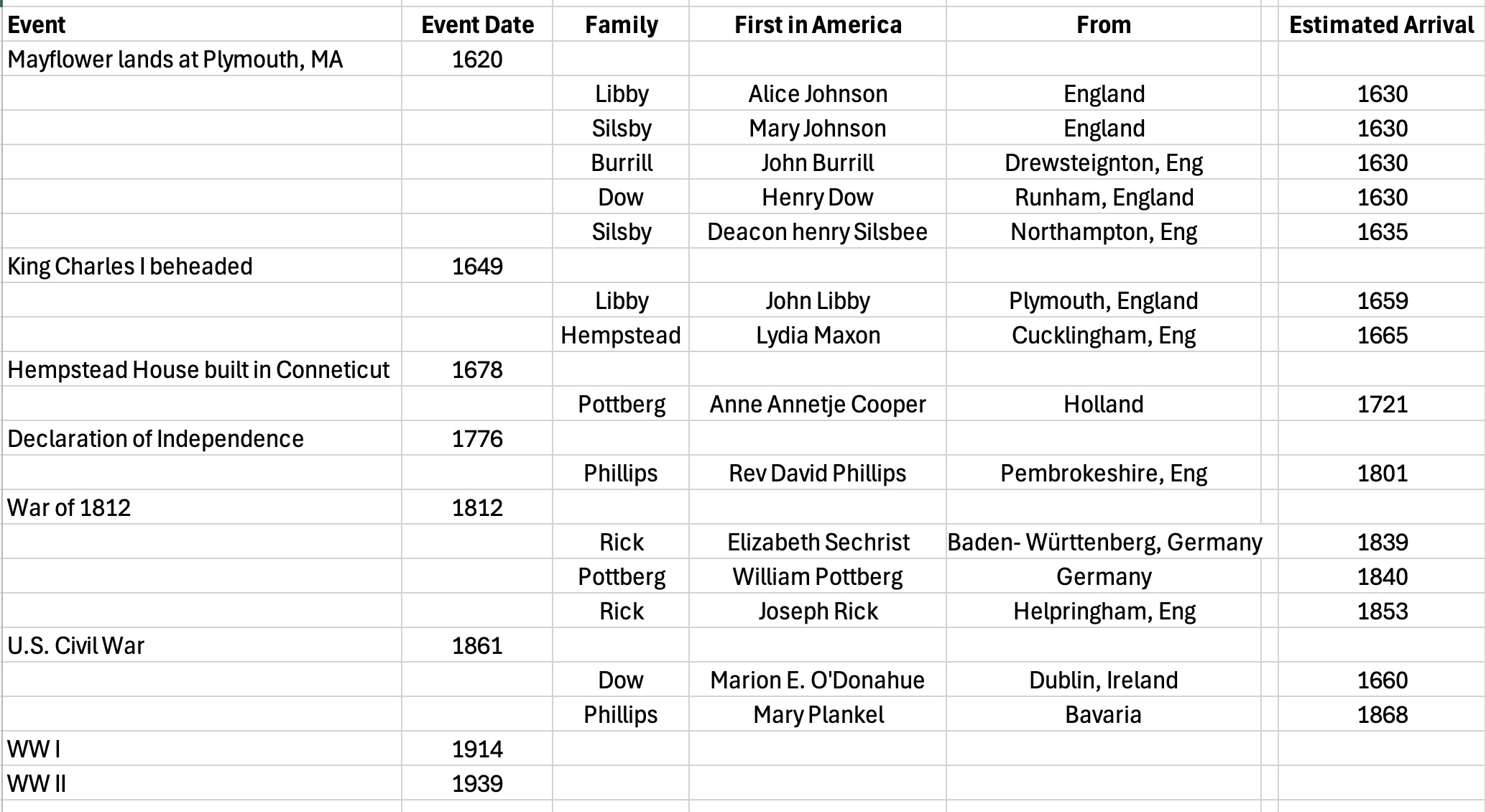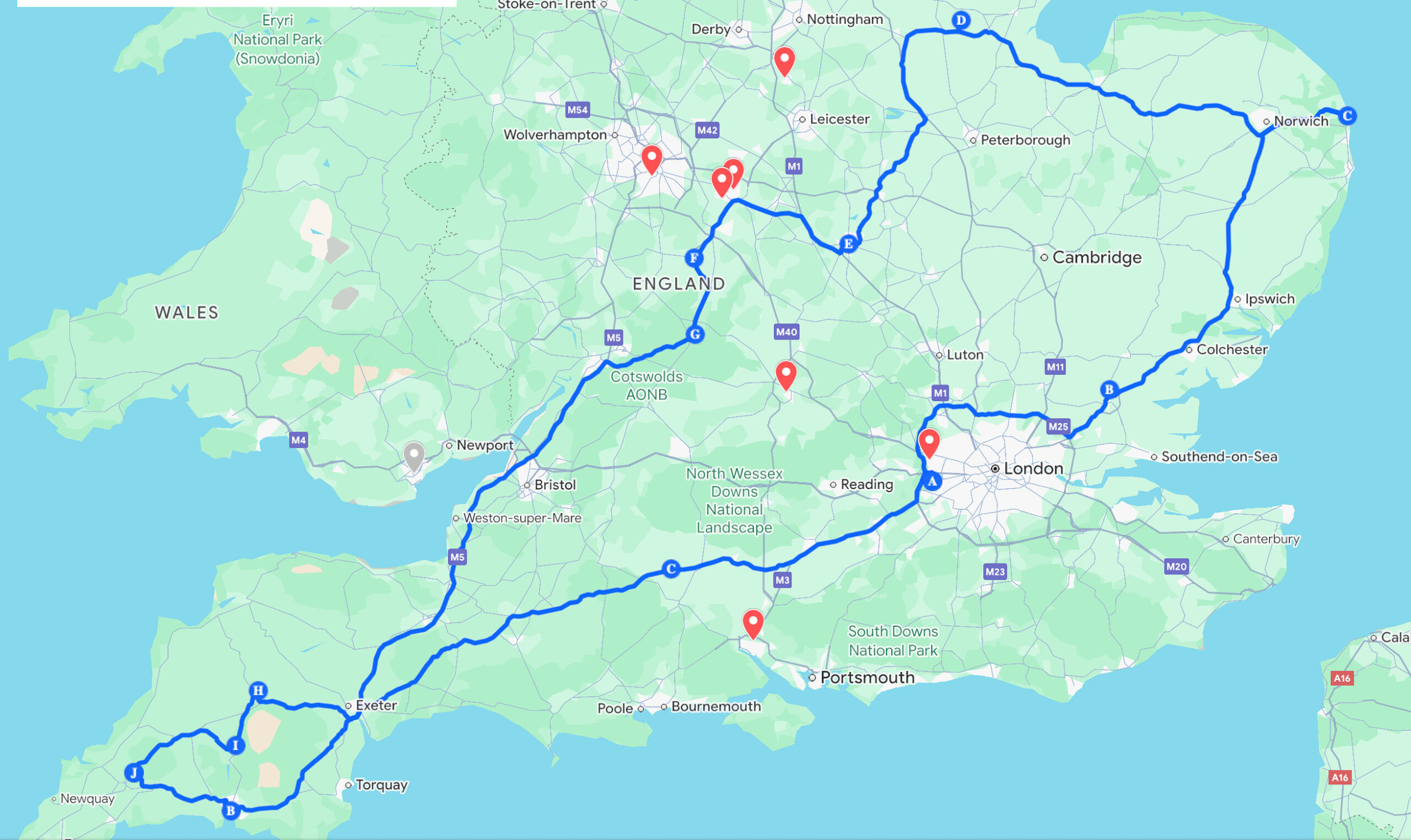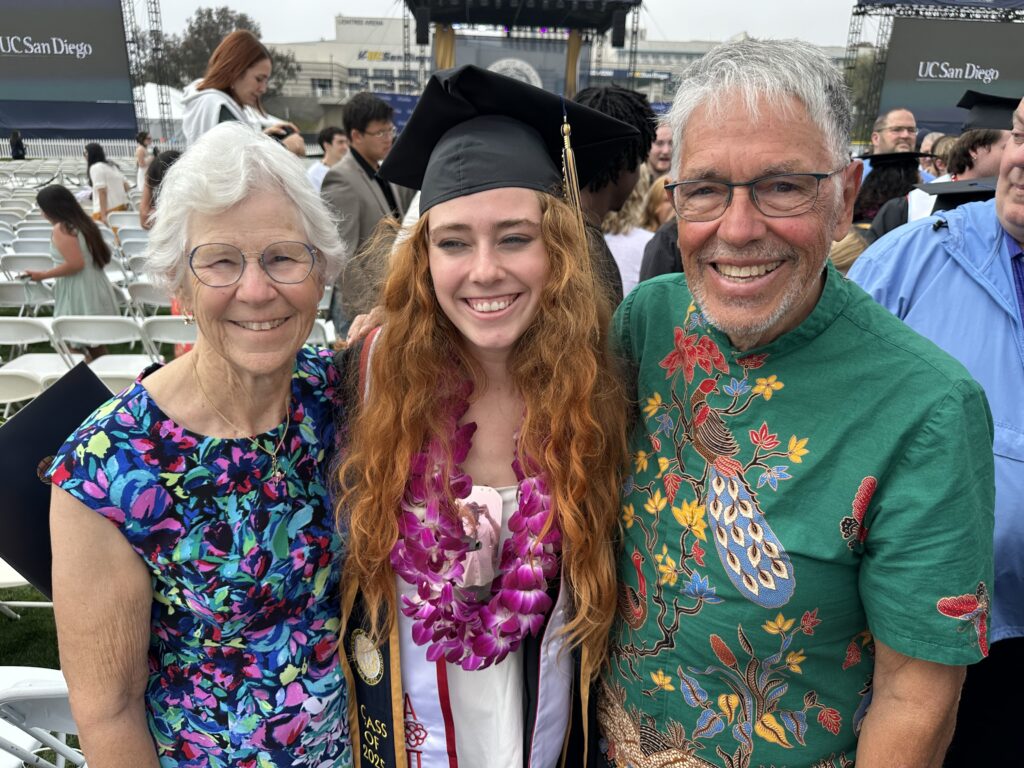Rick and Hempstead Family Genealogy Trip to England, June 19 – 27, 2025
Judy and I returned Monday from our granddaughter Reagan’s graduation from UC San Diego (insert sound of bursting buttons here) and we leave Thursday for England and Croatia. Never a dull moment!
 In preparation for our June 2025 trip to England, I have been researching the Rick and Hempstead genealogies. One objective is to find out from whence our ancestors came, hoping to visit those places in England that we can count as our ancestral homes. The trip is not to research genealogy but to get a feel for the environment and history of the places. I’ve also tried to research all branches of the family, not just the English ones. Our parents, particularly Lilian Libby Rick, her mother Dorothy Dow Libby and David Geer Hempstead, did a lot of research that I’ve tried to codify in the Hemp-Rick Tree on Ancestry.com.
Each of us has two sets of grandparents – a total of eight more-or-less different branches. Most genealogical studies tend to follow the male lines, since the male surnames tend to remain constant over the generations. I thought it would be fun to try to trace the female branches too, following mothers, not fathers, and see where each leads. Looking at it that way, our eight grandparents represent sixteen possible branches, one male and one female for each:
Jonathan Dow Rick
Father: Philip Grover Rick
Grandfather: Herbert Grover Rick
Grandmother: Alice Lenore Phillips Rick
Mother: Lilian Jeanette Libby Rick
Grandfather: Clifford Small Libby
Grandmother: Dorothy Lilian Dow Libby
Judith Anne Hempstead Rick
Father: David Geer Hempstead
Grandfather: Alfred Geer Hempstead
Grandmother: Ellen Vanness Pottberg
Mother: Margaret Frances Burrill Hempstead
Grandfather: Leslie Frank Burrill
Grandmother: Mary Cushman Silsby Burrill
If you really want to go crazy, we have 2*210 =2,048 possible lines going back 10 generations for the two of us, so 16 lines is only a drop in the DNA pool. Our grandkids each have 212 Â = 4,096 branches.
Our lines came to North America from the seventeenth to nineteenth centuries – roughly the early 1600s through the mid 1800s. Each branch and ancestor have some interesting stories passed down to us a few of which I’ve tried to capture.
I’ve been fascinated to imagine what life was like for our early ancestors and where they lived in the annals of history. Here’s a table that shows our ancestors superimposed on key historical events:

Seven of our lines come from England from the time of the Mayflower through the English Civil Wars and the reign of Oliver Cromwell as Lord Protector of the Commonwealth of England. The period was marked by a clash between Parliament and King Charles I over the balance of power between the two. King Charles I lost his head, literally, as a result. The concept of democracy was hinted at by the Levelers, but it took another 200 or more years for it to really take hold in England
It was also a period of great religious turmoil as the English, Scottish and Irish grappled with King Henry VIII’s earlier split with the Catholic Church and the establishment of the Church of England. Puritans and Presbyterians favored Calvinism. Some thought the King, Parliament and the bishops should have no control over religion. Congregationalists thought there should be no overarching religious structure at all; each congregation was on its own. The Quakers came into being during this period.
So, seven of our family lines, arguably, were members of the Puritan Great Migration, just like those on the Mayflower, seeking religious freedom and escape from the violence of the English Civil War. Of course, some who made the move were motivated by economic opportunity, as was the case with John Alden.
And yes, spoiler alert, Judy’s Burrill line can be traced back to John and Pricilla Alden. A Burrill married one of their granddaughters.
The rest of our forefathers/mothers were here for the U.S. Civil War or its immediate aftermath.
Here is a map of our trip:

And Here’s a legend, relating letters on the map to places we’ll stop:
A – Heathrow Airport, where the trip starts and stops
B – Essex, possible home of Mary Clark Cogswell ancestor of Jeannette Small Libby
C – Ormsby, St. Michael, home of the Dows
D – Helpringham, home of the Ricks
E – Northampton, home of the Silsbys
F – Stratford-upon-Avon, home of you-know-who (no known relation)
G – The Cotswolds, a break in the action in a scenic part of England
H, I – Drewsteignton-Devon, home of the Burrills
J – Cornwall, home of the Libbys
K – Portsmouth, from whence the Mayflower departed. John Alden’s hometown is not known
L – Stone Henge just because, and a drive-thru of nearby Cucklingham/ton, home of the female side of the Hempsteads (maybe)
We’ll do all that in a rental car over eight days. When we’re done, we’re off to Split, Croatia, for a week of relaxation as Jeff sails us around the Adriatic. Then back to Melrose for a day or two and then off to Onawa for the summer.
Now for the details. Non-family members can stop here. What follows will NOT be on the final exam. I’m posting it here to make it available to the family.
Herbert Grover Rick (1891 – 1964)
Grandpa Rick was born in Beaver County, Oklahoma Territory, 15 years before Oklahoma became the 46th state. The story is that he lived in a sod hut: a “soddie.†Maybe the family moved to Oklahoma from Camden, MI to be ready for the Cherokee Outlet Land Run of 1893. Oklahoma didn’t have many trees, so sod was used instead.
Grandpa Rick’s father, Erstin Rick (1859 – 1942) was therefore 32 when my grandfather was born in Oklahoma. Erstin died in North Adams, MI. Too much dust, no land in Oklahoma, I guess.
Grandpa Rick’s great grandfather, Joseph Rick was born 12 Dec 1814 in Helpringham, Lincolnshire, England and died 18 Dec 1891 in Camden, MI. He died the same year my grandfather was born. We’ll visit Helpringham on our trip.
Grampa Rick’s mother, Effie May Houtz (1862 – 1943) descended from Elizabeth Sechrist (1809 – 1869) who came from Baden-Würtenberg, Germany.
Alice Lenore Phillips Rick (1889 – 1979)
Grandma Rick was born near Camden, MI in Branch County. I’ve seen the house where she lived, not far from the cemetery where a number of relatives are buried. It was pretty run down and abandoned at the time so it likely isn’t there anymore. The family was dirt poor, she told me.
Her father was William Edgar Phillips (1859 – 1927) and her mother Cora Plankel. They were married in 1883 and divorced in 1900 when Grandma Rick was one year old. The Philips family seems to have come from Penbrokeshire, Wales. The first to come to America was Reverend David Phillips (1742 – 1859) who died in Washington, PA.
Cora Plankel Phillips remarried Wilfred L. Kirke in 1901when Grandma Rick was two years old. She never mentioned him to me, but he must have been her father figure as she grew up. From what I can see, the Plankel family came from Germany. Cora’s father, Markal (“Michaelâ€) Plankel was born in Baden, Germany in 1836 and died in Reading, MI in 1893. Cora’s mother, Mary Plankel, was born in Baryern, Baveria in 1842 and died in Quicncy, MI in 1893.
Wales and Bavaria are not on our travel plan this trip.
Clifford Small Libby (1884 – 1968)
Grandpa Libby’s English lineage comes from John Libby I, born 1636 in Plymouth, Devon, England and died 1682 in Cumberland, ME. There are 10 generations, spanning 389 years. Of those 10, three were named John, two Daniel and three William. Hard to keep them all straight. John (I) was a key founder of Scarborough, ME. He fought the Indians and lost two sons in King Philip’s War. Libby Hill, in Gray, ME is now a town park. I have a brick from the ruins of the James Parker Libby home on Libby Hill. The Dow homestead is at the foot of Libby Hill.
Following Grandpa Libby’s maternal line, starting with his mother, Jeannette Small Libby (1855 – 1946) possibly goes back ten or more generations to Mary Clark Cogswell who, with her husband, John Cogswell, sailed on the Angel Gabriel with their children in 1635. Mary seems to have come from Essex, England, although the records are not clear. They settled in Ipswich, MA, not far from Melrose, and known for their clams. I had Ipswich clams a few weeks ago at a restaurant in Essex, MA. Go figure. We’ll stop in Essex on our first day, rather than visiting Cambridge University as we’d originally planned. More research is needed to confirm these guesses.
Dorothy Lilian Dow Libby (1892 – 1967)
Grandma Libby’s mother, Lilian E David Kirkwood, grew up in Negaunee Michigan. It appears that her mother, Marion E O’Donahue was from Dublin, Ireland, born in 1844. She married three times, as far as I can tell, first to John Alden David (1865?) and then to August Schenck (1866) and finally to Philip Bogs Kirkwood (1874). Lilian therefore was the daughter of John Alden David. My mother said that maybe, given his name, we are descended from THAT John Alden, the one from the Mayflower. John Alden David’s genealogy is a dead end for me on Ancestry, so that claim is dubious. Judy’s claim to John Alden via the Burrills is the real deal.
Grandma Libby’s mother married Lorenzo Everett Dow, a Chicago lawyer from Grey, ME in 1890. She died in 1892 shortly after giving birth two twins. One twin died; Grandma Libby survived. Lorenzo sent baby Dorothy home with his mother, to be raised by his parents and maiden sisters at the Gray, ME homestead. He visited occasionally. He once sent her a pony and cart to drive to school, which she did as a grade-schooler. Much to my mother’s dismay, he never sent his brilliant daughter to college believing, I guess, that women didn’t need a college education. Lorenzo went on to be Treasurer of Hillsdale College. His granddaughter, Lilian, was sent to Hillsdale for her college education. There she me Phil Rick and hence, here I am.
The Dow line is long and interesting. Lorenzo, my great grandfather, had parents who were William Mitchel Dow and Mehitable Thayer Libby. Grandma Libby, Lorenzo’s daughter, married a Libby. A little incest going on here? Mom talked about the coincidence with a twinkle in her eye.
The Dow line goes back to Henry Dow (1606 – 1659) who was born in Runham, Norfolk England, lived near Ormesby and died in Rockingham, NH. Along the way was a Jonathan (1735 – 1808) for whom I am named.
Jonathan’s son, Beniah (1770 -1852) was born in Vermont, ran off with (or was abducted by) Indians, lived in Canada, turned up at Campobello Island and found his way with his wife to Paris ME. The Book of Dow and Grandma Libby’s narrative she left us details this character in great detail and is recommended reading. His father, Jonathan Dow, was something of a wild guy himself, moving frequently in New Hampshire and Vermont. He traded whiskey for furs with the Indians, drank a lot himself and died in Montreal.
Speaking of the Dow homestead, it was, I recall, built by John Muchmore in Gray, ME using prize money he was awarded for capturing a British ship in Portland Harbor by nailing down the hatches while the crew slept below. I’ll have to dig further to get the details from Grandma Libby’s documents.
Rev. Alfred Geer Hempstead
Tracing the lineage of Rev. Alfred Hempstead has always been a frustration for me. Ancestry records, and ChatGPT hit a dead end with Alfred’s grandfather, William Frank Hempstead (1811 – 1980). His father may have been Robert Hempstead, but Robert Hempsteads are a dime a dozen. There’s a Hempstead House in New London, CT, and the town of Hempstead, Long Island. There’s a book about Joshua Hempstead who owned a slave or two. But no linkage to Alfred’s line. Oh well.
Alfred’s mother, Emma Melissa Brooks (1860 – 1940) came from a long and distinguished line on the female side. Lydia Maxson (1612 – 1718), nine generations removed from Judy, was born in Cucklingham, Somerset England and died in Rhode Island. The Maxsons were apparently movers and shakers in the founding of Newport and Rhode Island in general. Her daughter, Mary Mosher, married Rev. John Maxson Sr. I assume there’s some mixup in the historical records. Surely Mary didn’t marry her cousin or, gasp, her uncle? Further research is NOT warranted.
I can’t find reference to Cucklingham but Cucklington is on the road we’ll travel to Stone Henge so it might be worth a drive through.
Ellen Vanness Pottberg (1889 – 1985)
Following the female line of Alfred’s wife Ellen is more productive. Eight generations before, Anne Annetje Cooper was born in Holland in 1691 and died in Woodbridge, NJ in 1750.
The father of Ellen’s father, Dr. Charles Pottberg of Philadelphia (1858 – 1938), was William Pottberg (?- 1894) who came from somewhere in Germany. The ancestory.com trail ends there.
Leslie Frank Burrill ( 1887 – 1947)
Judy never knew her grandfather; he passed away eight months before her birth. But he has a legitimate claim to being a Mayflower descendent.
The first Burrill reached America in 1634. Here’s what Microsoft Copilot’a artificial intelligence reports about John Burrill I:
John Burrill, born in 1609 in Drewsteignton, Devon, England, passed away between August 3, 1654 (the date of his will) and February 15, 1657 (the date his will was probated). He was a shoemaker who migrated to Massachusetts Bay in 1634 and lived in Roxbury and Boston during his life.
The Mayflower landed at Plymouth, MA in 1620, so John Burrill I isn’t a direct Mayflower descendent. But his son, John Burrill II, married Mercy Alden, the granddaughter of Pricilla and John Alden. That’s the union that infused the Burrill line with Mayflower DNA.
So far, I haven’t been able to trace Leslie Frank Burrill’s mother’s line past his grandmother, Mary Hackett Lovejoy (1832 – 1857) who lived in Kenduskeag, ME.
Mary Cushman Silsby Burrill (1893 – 1989)
The Silsby line is another old one, dating back to Deacon Henry Silsbee, (1613 – 1700). Born in Northampton, England, he came to Lynn, MA around 1635. The family seems to have made their way to Connecticut. Jonathan Silsby was born in Lynn but got married in Windham, CT around 1709. By 1812 they were in Acworth, NH and by 1825 Samuel Silsby died in Aurora, ME. There’s a whole story about six Silsby brothers coming to Aurora, each staking out a claim to a hill. The Silsbys have been movers and shakers in Aurora and the State of Maine ever since.
The female line starting with Mary Cushman Silsby Burrill traces back to Mary Johnson who came to Rhode Island in the early 1600s, but not on the Mayflower. Some family trees claim a link to the Aldens, but maybe through collateral lines that lead to “our†Alden connection.
Â
Â

